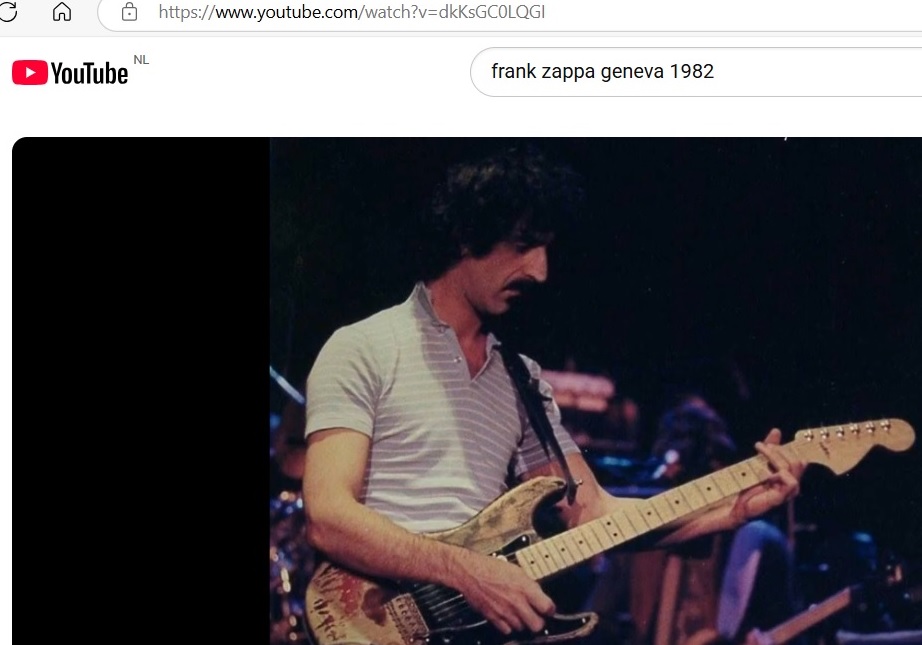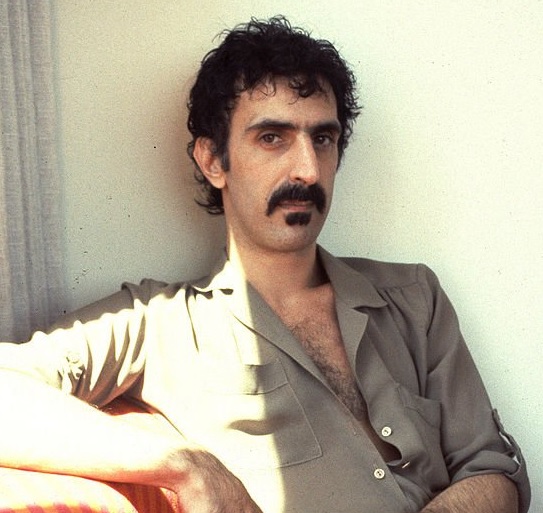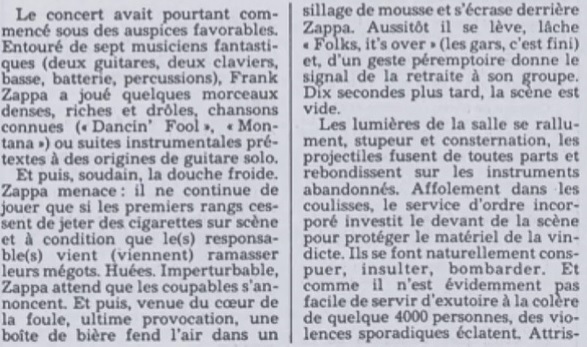YCDTOSA VOL. V, DISC 2: LIVE COMPILATIONS #2
Zappa introduces disc 2 of Vol. V of the "You can't do that on stage anymore" series as: "Disc 2 of this set is dedicated to the 1982
band. About half of the material comes from our ill-fated concert in Geneva, Switzerland (which ended with a small riot). The 1982 tour
itself ended with a much larger riot in Palermo, Sicily a few weeks later. The '82 band could play beautifully when it wanted to. It is unfortunate
that the audiences of that time didn't inderstand that we had no intention of posing as targets for their assorted "love offerings" cast onto the stage
(in Milan they threw used hypodermic syringes)".
All tracks come from the European summer tour, recorded in Geneva, Munich, Balzano and Frankfurt. Indeed the quality of these tracks is high.
Other than volumes I, III, IV and VI the material from volumes II and V can be chronologically assigned to specific years or periods. Because
of that they have sections of their own in this study. Disc 1 of vol. V concerns the period 1965-9.
Shall we take ourselves seriously
Next is a short jazz composition, called "Shall we take ourselves seriously", the jazz element being effected by the free
bass movement, syncopes and the shifting through keys. I've notated bar 1 in C, bar 2 in C Dorian and for the remainder I'm using an F#
in the presets only because the F is mostly sharp. One might just as well use no presets.
Shall we take ourselves seriously, opening (midi file).
Shall we take ourselves seriously, opening (transcription).
The meter of this piece remains 4/4,
but the subdivision keeps varying. It can be standard 4/4, but you also have a lot of beats with triplets (more like 12/8), as well
as triplets over two beats. During bars 13-16 you've got a chord that goes syncopically over a bar, using a triplet.

The Geneva 1982 concert got bootlegged in full, making it possible to identify which tracks were recorded at Geneva.
Dead girls of London
"Dead girls of London" is the opening number of L. Shankar's "Touch me there" album from 1979, produced by Zappa.
On that album Zappa gets credited for the lyrics and co-credited for the music. "YCDTOSA vol. V" contains a 1982
recording by Zappa's own band. On that CD Zappa credits himself for the lyrics only. If there's a reason for this I can't tell.
Anyway, the 1982 rendition contains an ending, that's not included in the 1979 album. It takes up 20 seconds of the 2:28 length of this track.
Dead girls of London, 1:55-2:18 (midi file).
Dead girls of London, 1:55-2:18 (transcription).
Bars 1-4 of the example from above contain the end of this song in the manner of the 1979 album. Bars 5-9 are the 1982 addition by Zappa, drawing
upon material from "Approximate" from 1974. Only the lyrics relate to the main part of this song. The music is deliberately irregular:
- Bar 5: spoken text, "boutique frame of mine".
- Bar 6: a quituplet with jumping notes.
- Bar 7: spoken text, "gee, I like your pants".
- Bar 8: a chromatic string of notes.
- Bar 9: four low ticks followed by a guitar glissando.
Next bars 5-9 get repeated once in full and once more till half-way. See the Joe's garage section of this study for more about Shankar's album.
RDNZL (1982)
"RDNZL" got composed around 1972 and reached its final form in 1974. On album it first appeared on "Studio tan". See the corresponding section
for several examples from "RDNZL (1972-8)" as it got played during the seventies. The 1982 band played
this song without further changing the written themes, so it's the soloing and improvisations that make the difference.
RDNZL (1982), 1:38-2:02 (midi file).
RDNZL (1982), 1:38-2:02 (transcription).
This first example is the beginning of the guitar solo with a I-II alternation in A Lydian as on "Studio tan". Like in 1978 quite some bars
are spent on just playing this alternation by the band, 1:22 through 1:46. I've included the last three bars of this in the example above.
In bar 4 Zappa starts soloing, continuing till 4:44.
RDNZL (1982), 5:19-5:41 (midi file).
RDNZL (1982), 5:19-5:41 (transcription).
The first bar from this second example is the last normally written bar of the middle section. It gets followed by bars 2-8 that contain
improvising irregularly in 4/4 for a bar, alternating with a bar with laughter, also lasting 4/4. It's the kind of insertions Zappa liked to do
more often: deliberately irregular and without a connection to the remainder of the song. None of this is notated with great precision.
In midi format the laughter doesn't come out well, so I've tuned down these notes in the midi file. Next a vamp gets introduced for playing keyboard solos.
This vamp is a rhythmic figure in F Mixolydian alternating the F and Eb chords on guitar (staff 2). In bars 9-12 you can see that the keyboard part from staff
1 extends these chords with a D and a C, so one might also call them Dm7 and Cm7 at this point. In bar 13 the keyboard solo starts.
Pound for a brown (1982)
 To the right: Zappa at home in 1982 (outtake of a photo by Chris Walter). "Pound for a brown" was used during most tours for giving band members a chance to solo. Only the first 1:10 minutes of this 8:38 minutes track are the written compostion
(see "Pound for a brown" from the Lost episodes section for the written part).
At 2:47 an accompanying figure starts that gets maintained through the end of the song. It starts with ticking chords as 16th notes till you get at the end of beat 3,
where you can hear an accentuated chord just before beat.
To the right: Zappa at home in 1982 (outtake of a photo by Chris Walter). "Pound for a brown" was used during most tours for giving band members a chance to solo. Only the first 1:10 minutes of this 8:38 minutes track are the written compostion
(see "Pound for a brown" from the Lost episodes section for the written part).
At 2:47 an accompanying figure starts that gets maintained through the end of the song. It starts with ticking chords as 16th notes till you get at the end of beat 3,
where you can hear an accentuated chord just before beat.
Pound for a brown (1982), 6:00-6:23 (midi file).
Pound for a brown (1982), 6:00-6:23 (transcription).
The example above is taken from the point where Zappa himself begins soloing. In bars 2-5 the bass move over from F to C to G.
By itself one might call it F major, but during the preceding bars G serves as the tonic. So G Dorian suits better.
Bar 1 is the vamping figure by itself, where the notes and rhythm can be well recognized. When Zappa starts soloing in bar 2, the vamp gets less loud, being
overshadowed by the volume of the guitar solo. You can hear it's still present, but transcribing the individual notes is more guessing than hearing them with certainty.
Advance romance (1982)
The lead melody from "Advance romance (1975)" is present in the Bongo Fury section of this study, a transcription from the
Wolfgang Ludwig study.
The example from below starts with the end of the 1982 solo, that got released earlier as "Jim and Tammy's upper room".
In the Guitar section you can find the opening of this solo.
Advance romance (1982), 4:58-5:51 (midi file).
Advance romance (1982), 4:58-5:51 (transcription).
- bars 1-5: end of the guitar solo. The bass is still playing the G pedal in a rather basic manner, the key being G Dorian.
- bars 9-19: return of motifs from the opening theme. During bars 8-10 and bars 12-15 the sung melody is either a sustained note or pausing,
leaving much room for the other instruments to improvise.
- bars 20-27: a repeated motif of two bars, starting unisono and moving towards a chord progression for the singers. It's an example
of a speech-influenced rhtyhm. It sounds perfectly natural, but when transcribing it you'll notice that various notes start before beat.
One can also notice that the B keeps switching between natural and flat.
- bar 28: "she might be the devil" etc.
City of tiny lites (1982)
The band started playing "City of tiny lites (1976-8)" in 1976, released on the ZFT issue "Philly '76".
Zappa himself first released this song on "Sheik Yerbouti". Examples from both CDs are included in the FZ:OZ section. During the 1980 fall tour
Zappa started to play a guitar solo during this song over a vamp, that has become known as the Carlos Santana vamp. See the Shut up 'n play yer
guitar section at "Variations on the Carlos Santana secret chord progression" for the details.
City of tiny lites (1982), 9:27-9:43 (midi file).
City of tiny lites (1982), 9:47-10:00 (midi file).
City of tiny lites (1982), 9:27-9:43 (transcription).
City of tiny lites (1982), 9:47-10:00 (transcription).
Also during this track he's soloing over the Santana vamp. It takes up 2:14 through 7:37 of the song. Next you can hear a reprise of the sung themes till the end of this song at 10:37,
but in extravagant manner:
- This part gets sung over the Santana vamp too.
- Ray White can improvise freely along the written lines.
- Every couple of bars the normally sung part gets interrupted by short intermezzos.
Breaking a melody by unrelated intermezzos is something Zappa liked to do more often.
See for instance the comments about breaking the opening melody of "Inca roads" in the One size fits all section. Here it's done to the max.
The outlines of this part of the song must have been rehearsed, but there's a lot in it that could be improvised. There's a good chance that Zappa was conducting during this
section of the song to keep everything equal. In bar 2 of my first example you can hear the band singing a high note at the same moment. The content of bars 9-11 looks
completely improvised. It's for synthesizer and synthesizer toms plus drums with otherwise only the number of bars being preset.
The second example begins with a sustained chord, coming over from the previous bar. Bars 8-9 contain a figure around which the band could improvise.
Doreen (1982)
The studio version of "Doreen (1981)" comes from the "You are what you is" album with
two examples being included in the corresponding section. The example below is transcribed from the 1982 live version
on "You can't do that on stage anymore, vol. V", where this song is played in E.
Doreen, opening (midi file).
Doreen, opening (transcription).
The conventional structure of this song is described in the You are what you is section. What's less conventional is that the sung melody doesn't try to be a part of the chords,
but is moving freely through it. The keyboard chords and vocal harmonies are responsible for the difference with the studio version of the opening.
The bigger difference lies in the vocal vamp that ends the song. It's a different figure, not being used for playing a guitar solo over it. Because of that this
live version lasts only 1:59 compared to the 4:43 minutes on "You are what you is".
Easy meat (1982)
"Easy meat (1980)" got its final form in 1980. See the Tinsel town rebellion section for its history.
The band kept playing this song during the 1981-2 tours with the written part being unaltered.
Easy meat (1982), 2:45-3:04 (midi file).
Easy meat (1982), 2:45-3:04 (transcription).
The solo in it takes up half of the song, 2:37 through 6:24, probably the reason Zappa found it interesting enough to include this title in "YCDTOSA Vol. V".
In the previous section I've included another example from the Halloween 81 concerts. The example above begins with six bars with the band improvising in Eb Lydian.
Scott Thunes plays a little motif, that gets transposed. As about always, there's no connection between the solo and the written part, other than the key.
So, in effect, you've got 4 minutes of unreleased music with this title.
Geneva farewell
The track on YCDTOSA V can be heard in a wider context on the bootleg recording from above: "Ok, here is a warning, if you throw anything else onto the stage, the concert is over. And we only play anything else, I want the person who threw the
cigarette on here located and removed from the concert ... elsewise the concert is over".

In 24 Heurs a review by Antoine Duplan appeared with the title, in English: "A concert in turmoil, Zappa closes the door".
It says that everything went fine till: "And then, suddenly, the cold shower. Zappa threatens: he will not continue playing
if people from the first rank don't stop throwing cigarettes on stage and that the person(s)
responsible should come to pick up the butts. Yelling. Unperturbud, Zappa announces
that they should identify themselves. Next, from the middle of the audience,
the last provocation, a bottle of bear flies through the air with foam in its tail,
crashing behind Zappa. He rises up saying "Folks, it's over", giving a clear sign
to his band to leave the stage. 10 seconds later, the stage is empty."
When you're looking for the subject of throwing things on stage on internet, you can read that it came up in the late seventies, affecting all kinds of bands.
Security measures had to be sharpened. As I recall it from the 1988 concert at Ahoy, Rotterdam, a couple of fans were waving their panties at the end of the concert,
but when they tried to approach the stage, to their surprise they were halted by security people. Things had changed since the "Panty rap" era.
Other tracks from Vol. V, disc 2:
- The "What's new in Baltimore?" version from 1982 is included in the Frank
Zappa meets the mothers of invention section.
- The guitar solo from "The black page #2" got released earlier as a seperate track, "Which one is it?".
See the Guitar section for more.
